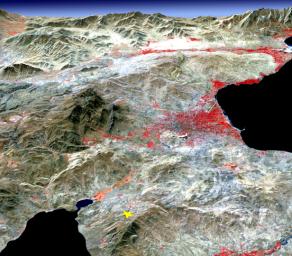On Sunday, Oct. 23, 2011, a magnitude 7.2 earthquake struck eastern Turkey, near the city of Van. Turkey is a tectonically active country, experiencing frequent devastating earthquakes. This one was the result of the collision between the Arabian and Eurasian tectonic plates, causing Earth to be squeezed. This perspective view was created from an image acquired Oct. 10, 2001, from the Advanced Spaceborne Thermal Emission and Reflection Radiometer (ASTER) instrument on NASA's Terra spacecraft, draped over topographic data. The earthquake epicenter is indicated by the yellow star. Vegetation, dominantly agricultural, is displayed in red. The water body in the lower left is Lake Ercek; the larger water body on the right side is Lake Van. Hardest hit was the city of Van, located on the eastern shore of Lake Van, in the center of the image. The topographic relief has been exaggerated by a factor of two. The image is located at 38.6 degrees north latitude, 43.5 degrees east longitude.
With its 14 spectral bands from the visible to the thermal infrared wavelength region and its high spatial resolution of 15 to 90 meters (about 50 to 300 feet), ASTER images Earth to map and monitor the changing surface of our planet. ASTER is one of five Earth-observing instruments launched Dec. 18, 1999, on Terra. The instrument was built by Japan's Ministry of Economy, Trade and Industry. A joint U.S./Japan science team is responsible for validation and calibration of the instrument and data products.
The broad spectral coverage and high spectral resolution of ASTER provides scientists in numerous disciplines with critical information for surface mapping and monitoring of dynamic conditions and temporal change. Example applications are: monitoring glacial advances and retreats; monitoring potentially active volcanoes; identifying crop stress; determining cloud morphology and physical properties; wetlands evaluation; thermal pollution monitoring; coral reef degradation; surface temperature mapping of soils and geology; and measuring surface heat balance.
The U.S. science team is located at NASA's Jet Propulsion Laboratory, Pasadena, Calif. The Terra mission is part of NASA's Science Mission Directorate, Washington, D.C.
More information about ASTER is available at http://asterweb.jpl.nasa.gov/.

 Planetary Data System
Planetary Data System












